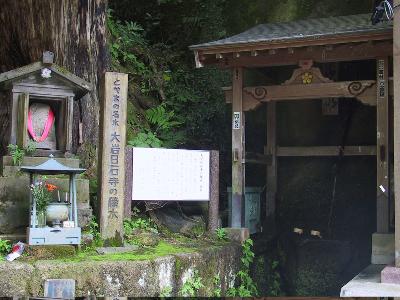|
Ooiwasan Nisekiji Temple is famous for its holy water called 'fujimizu' (fuji water), which is believed to cure ailments of the eyes. The temple is in Nakanigawa-gun, Toyama Prefecture.
The 'Etchu-kujiki' records relate a legend from 1702 about a blind farmer who lived in Echigo. One day, he received a divine message from Fudo-Myoo (Vidyaraja, one of Buddhism's Five Kings of the four cardinal directions) telling him to wash his eyes under a 'fuji' tree near a waterfall in Nisekiji Temple. The farmer heeded Fudo-Myoo's words and, immediately after washing his eyes, was able to open them and see again.
To this day at the temple, the spring water that wells out around the statue of Fudo-Myoo (an important cultural property of Japan), has been known as Fujimizu, and is believed to miraculously cure eye diseases.
Also within this temple is the megusuri-no-ki ('eyewash tree'), said to cure presbyopia. Dried megusuri-no-ki for decocting in tea is sold here and has proved popular with visitors.
The 'Etchu-kujiki' records relate a legend from 1702 about a blind farmer who lived in Echigo. One day, he received a divine message from Fudo-Myoo (Vidyaraja, one of Buddhism's Five Kings of the four cardinal directions) telling him to wash his eyes under a 'fuji' tree near a waterfall in Nisekiji Temple. The farmer heeded Fudo-Myoo's words and, immediately after washing his eyes, was able to open them and see again.
To this day at the temple, the spring water that wells out around the statue of Fudo-Myoo (an important cultural property of Japan), has been known as Fujimizu, and is believed to miraculously cure eye diseases.
Also within this temple is the megusuri-no-ki ('eyewash tree'), said to cure presbyopia. Dried megusuri-no-ki for decocting in tea is sold here and has proved popular with visitors.
| [+ADDRESS] | 
|













